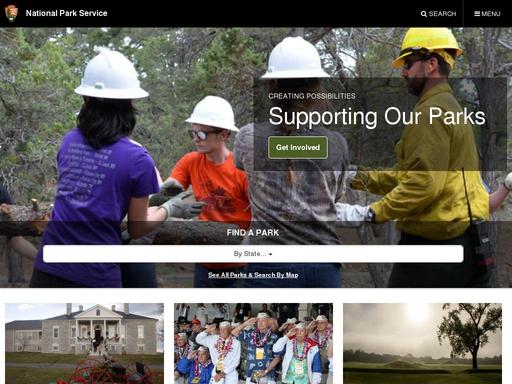Rate Padre Island National Seashore
Learn and Explore
Since 1916, the National Park Service has been entrusted with the care of our national parks. With the help of volunteers and partners, we safeguard these special places and share their stories with more than 275 million visitors every year. But our work doesn’t stop there.
We are proud that tribes, local governments, nonprofit organizations, businesses, and individual citizens ask for our help in revitalizing their communities, preserving local history, celebrating local heritage, and creating close to home opportunities for kids and families to get outside, be active, and have fun.
Taking care of the national parks and helping Americans take care of their communities is a job we love, and we need—and welcome—your help and support.
Our Mission
The National Park Service preserves unimpaired the natural and cultural resources and values of the National Park System for the enjoyment, education, and inspiration of this and future generations. The Park Service cooperates with partners to extend the benefits of natural and cultural resource conservation and outdoor recreation throughout this country and the world.
Frequently Asked Questions
How do I obtain a park entrance pass?
Only 118 of your 417 park sites charge entrance fees. You can obtain park entrance passes by visiting a park site that charges an entrance fee. Entrance fee sites have passes available; we recommend calling a park prior to your visit. (See the park search to locate a specific park.) There are a number of entrance passes available, including park-specific passes as well as passes that offer entrance to more than 2,000 federal recreation sites in addition to the national parks (Annual, Military, Senior, 4th Grade, Access, and Volunteer passes). Learn more about the America the Beautiful – The National Parks and Federal Recreational Lands Pass.
About this location:
National Seashore
Operating Hours & Seasons
Overall park access hours
The park is open 24 hours per day, 365 days per year. However, park facilities are not open 24 hours per day. Hours for the entrance station, where the required entrance pass is sold, vary from day to day. If the entrance station is not open when you arrive, you can proceed into the park. If you are camping, go back to the entrance station the next morning and obtain an entrance pass. If not camping, pay the entrance fee as you leave if the entrance station is open.
Standard Hours
- Sunday:Open 24 hours
- Monday:Open 24 hours
- Tuesday:Open 24 hours
- Wednesday:Open 24 hours
- Thursday:Open 24 hours
- Friday:Open 24 hours
- Saturday:Open 24 hours
Fees & Passes
Entrance Fees:
- $10.00 – Padre Island Vehicle Entrance Fee
This fee provides entrance into the park for one private, standard passenger vehicle for up to 7 days. It covers all occupants of the vehicle. - $5.00 – Padre Island Bicycle/Pedestrian Entrance Fee
This fee provides entrance into the park for one pedestrian or one bicycle for up to 7 days. - $5.00 – Bird Island Basin Use Fee
This fee provides for use of the Bird Island Basin area within Padre Island National Seashore for one day. It covers all occupants of one private, standard passenger vehicle. Bird Island Basin provides access to the Laguna Madre and has a boat ramp, windsurfing and kayaking area, and camping area. Please note this fee is in addition to the park entrance fee.
Entrance Passes:
- $20.00 – Padre Island Annual Pass
This pass entitles one private, standard passenger vehicle and its occupants to enter the park for one calendar year from the month of purchase. - $10.00 – Bird Island Basin Annual Pass
This pass entitles one private, standard passenger vehicle and its occupants to enter the Bird Island Basin area of Padre Island National Seashore for one calendar year from the month of purchase.
About
The Longest Stretch of Undeveloped Barrier Island in the World
Padre Island National Seashore separates the Gulf of Mexico from the Laguna Madre, one of a few hypersaline lagoons in the world. The park protects 70 miles of coastline, dunes, prairies, and wind tidal flats teeming with life. It is a safe nesting ground for the Kemp’s ridley sea turtle and a haven for over 380 bird species. It also has a rich history, including the Spanish shipwrecks of 1554.
Directions
The National Seashore is located on North Padre Island, southeast of the city of Corpus Christi, Texas. Visitors to the area should head east through Corpus Christi on Highway 358. After crossing the JFK Causeway onto Padre Island, Highway 358 changes to Park Road 22. Continue about 10 miles south on Park Road 22 to reach the park entrance.
Visitor Centers
Malaquite Visitor Center
The Malaquite Visitor Center includes a bookstore and an exhibit area with information about park history, plants, and animals. Free programs are offered daily. A shaded picnic area is available on the deck. Restrooms and cold water showers are available in the bathhouse. Wheelchair users can borrow a special beach wheelchair from the visitor center at no charge. An accessible ramp goes from the Pavilion down to Malaquite Swimming Beach.
Weather
Padre Island has long, hot summers and short, mild winters. Summers are very humid. Winter can bring strong cold fronts and gale force winds. Most rain falls near the beginning and end of hurricane season (June-October). Average seasonal temperatures (Fahrenheit) are: Spring – high 70s-80s, low 50s-60s; Summer – high mid-90s, low 70s; Fall – high 70s-80s, low 50s-60s; Winter – high 50s-70s, low 30s-40s. Year-round, average wind speed ranges from 5-25 miles per hour. Relative humidity seldom drops below 70%.









